| Sacred Space: Reflections Mahadeva in Braj - A Vaishnava Perspective
|
||||||||||||||
The vast litany of references to Sri Mahadeva, Shiva, in the predominantly Vaishnava lore of Braj establishes the irrevocability of his importance to those on the path of Krishna prema.
sri krsne vaisnavanam tu prema-bhaktir vivardhate
---Hari-bhakti-vilasa 14.203
"The loving devotion of the Vaisnavas for Sri Krishna greatly increases by the mercy of Shiva who distributes the essence of krsna-bhakti-rasa."
The Bhagavatam (12:13 16) states : |
Reflections • Yagya • Pratyahara • Aum-kar
Masters & Sages
Pilgrim Trails
Bookshelf
Mahadeva is considered the kshetrapal (protector of the land) of Braj.
Nandishwar Parwat in Nanda Gaon is considered to be Lord Shiva himself. This is the hill where Nanda Maharaj built his palace after he relocated his clan from Gokula where they were being regularly terrorized by the demonic emissaries of Kamsa.
Mahadeva in Nandgaon
Yasoda Mayi then sought a talisman for her Laalaa (beloved boy), to ensure that he would never cry again. Mahadeva replied he had one somewhere in his matted locks and as it would be too difficult to take out, the effect she sought could be had if she would put her son's feet on his head.
Even today, one of the five main lingas of Braj is worshiped here at Nanda Bhavan. The temple priests offer the prasad (offerings of food) from the main temple to Nandishwara Mahadeva as he is known here.
The form of Aasheshwar Mahadev, also one of the five svayambhu (self manifest) lingas in Braj, is still worshipped here, besides the kund (sacred water tank) of the same name.The banyan tree under which Shiva sat still stands by the kund. It is a substantiated belief amongst the Brajbasis that all wishes are granted here - just as Mahadeva's great hope, 'asha', to behold his beloved Lord Krishna was.
Mahadeva in Vrindavan: Gopeshwar Mahadev
Desiring to be part of this circle of dance, or the circular dance, Shiva arrives at the opposite shore of the Yamuna from Vrindavan. Vrinda-devi, the protector goddess of the forests of Braj, bars Shiva's entry. As Krishna is the only male, in whose company the gopis will dance, the austere Shiva, the epitome of masculinity, is obliged to transform into a gopi. This is achieved by entering into the waters of Manasarovar. At the temple at Vamsi Vat in Vrindavan, his linga form is worshiped in its natural state as a bare stone in the morning; in the evening it is adorned and outfitted in the feminine aspect, replete with crown and female countenance, eyes outlined with collyrium/ kohl and nose ring to depict this changeover of Shiva as a gopi.
Photo Credit:
| |||||||||||||
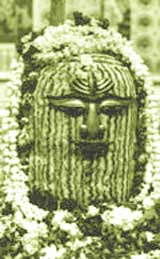 Many years after Krishna left this world, Arjuna the Pandava ruler of Indraprastha (present day Delhi), brought Vajranabha, Krishna's great- grandson, from Dwarka to Braj and appointed him king of the land of Krishna's childhood and youth. Braj at the time, after the great war depicted in the epic Mahabharata, had been abandoned and the legendry places of Krishna had become untraceable. The head priest of the cowherds, Sandhilya, was sought and the sacred domains of Krishna's lila (activities) were once again mapped. Vajranabha facilitated the establishment of village settlements around the sacred spaces so that they could be preserved. He also memorialised Krishna's presence in the four quarters of Braj by establishing the temples of Govindeva in Vrindavan, Keshavdeva in Mathura, Harideva in Govardhan and Baladeva in Dauji. He consecrated the presence of Shiva in his linga form at four sites; Gopeshwara in Vrindavan, Bhuteshwara in Mathura, Chakreshwara in Govardhana and Kameshwara in Kamban.
Many years after Krishna left this world, Arjuna the Pandava ruler of Indraprastha (present day Delhi), brought Vajranabha, Krishna's great- grandson, from Dwarka to Braj and appointed him king of the land of Krishna's childhood and youth. Braj at the time, after the great war depicted in the epic Mahabharata, had been abandoned and the legendry places of Krishna had become untraceable. The head priest of the cowherds, Sandhilya, was sought and the sacred domains of Krishna's lila (activities) were once again mapped. Vajranabha facilitated the establishment of village settlements around the sacred spaces so that they could be preserved. He also memorialised Krishna's presence in the four quarters of Braj by establishing the temples of Govindeva in Vrindavan, Keshavdeva in Mathura, Harideva in Govardhan and Baladeva in Dauji. He consecrated the presence of Shiva in his linga form at four sites; Gopeshwara in Vrindavan, Bhuteshwara in Mathura, Chakreshwara in Govardhana and Kameshwara in Kamban.
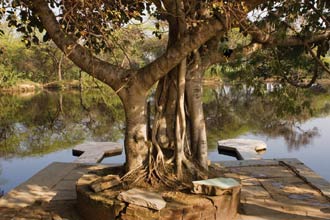 Additionally there are many kunds or sacred water bodies, with connections to Shiv Shankar Bhagavan: Aashishvar Mahadev in Nandagraam, Chandreshwar Mahadev in Kamvan to name a few.
Additionally there are many kunds or sacred water bodies, with connections to Shiv Shankar Bhagavan: Aashishvar Mahadev in Nandagraam, Chandreshwar Mahadev in Kamvan to name a few.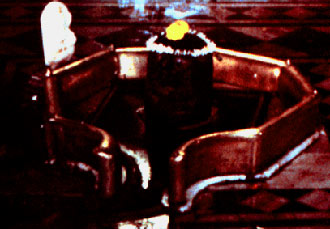 Lord Shiva arrived at Nandabhavan from his abode at Mount Kailash, eager to see Lord Krishna in the role of a cowherd boy. Yasoda begged him to leave as she could barely look upon the ash covered, digambar (sky-clad) Baba. He looked unkempt, with matted locks piled high on his head. Snakes draped themselves around his shoulders and neck and he wore an ornamental necklace of human skulls.
How, she pleaded with him, would her young son be able to bear the sight of this formidable form when she was almost faint with fear herself? She denied all his entreaties and Mahadeva departed. He did not go very far though. He found a forest towards the east of Nandagaon, settled under a banyan tree and assumed his samadhi state.
Lord Shiva arrived at Nandabhavan from his abode at Mount Kailash, eager to see Lord Krishna in the role of a cowherd boy. Yasoda begged him to leave as she could barely look upon the ash covered, digambar (sky-clad) Baba. He looked unkempt, with matted locks piled high on his head. Snakes draped themselves around his shoulders and neck and he wore an ornamental necklace of human skulls.
How, she pleaded with him, would her young son be able to bear the sight of this formidable form when she was almost faint with fear herself? She denied all his entreaties and Mahadeva departed. He did not go very far though. He found a forest towards the east of Nandagaon, settled under a banyan tree and assumed his samadhi state.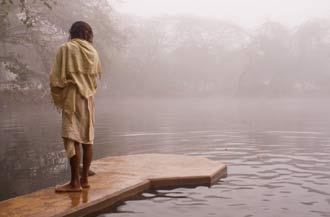 Soon after Mahadeva's departure, baby Krishna began to cry. Nothing and no one was able to placate him. On deliberation, it was ascertained that Yasoda's refusal of the Baba's request was an offence and might be the cause of Krishna's unrelenting tears. Mahadev was sought and found, rapt in meditation. As soon as Krishna beheld his most exalted devotee, he stopped crying and smiled with delight.
Soon after Mahadeva's departure, baby Krishna began to cry. Nothing and no one was able to placate him. On deliberation, it was ascertained that Yasoda's refusal of the Baba's request was an offence and might be the cause of Krishna's unrelenting tears. Mahadev was sought and found, rapt in meditation. As soon as Krishna beheld his most exalted devotee, he stopped crying and smiled with delight.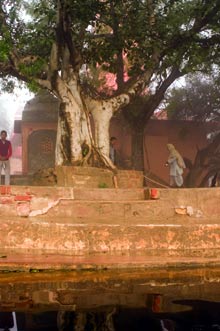 When asked what they could do for Mahadeva in return, he asked for the prasad of Krishna's meals.
When asked what they could do for Mahadeva in return, he asked for the prasad of Krishna's meals. 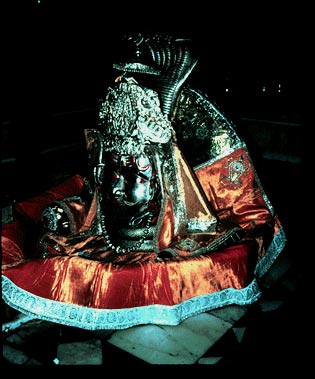 In the repose of his meditation, Shiva is aware of Krishna's play in Vrindavan. The bliss, or ananda, is too overpowering, as he sees, in his mind's eye, the images of the euphoric rasa dance. He sees Krishna satisfying every gopi (milk maid) by mystically being with each of them simultaneously. Shiva too wants to be part of this joyous celebration. An oft heard remark in Vrindavan is that indeed there is no shanta rasa (neutral or static peace) here - there is only the experience of ananda, utter bliss.
In the repose of his meditation, Shiva is aware of Krishna's play in Vrindavan. The bliss, or ananda, is too overpowering, as he sees, in his mind's eye, the images of the euphoric rasa dance. He sees Krishna satisfying every gopi (milk maid) by mystically being with each of them simultaneously. Shiva too wants to be part of this joyous celebration. An oft heard remark in Vrindavan is that indeed there is no shanta rasa (neutral or static peace) here - there is only the experience of ananda, utter bliss.